Why Does My Baby Keep Rubbing and Pulling Their Ear?
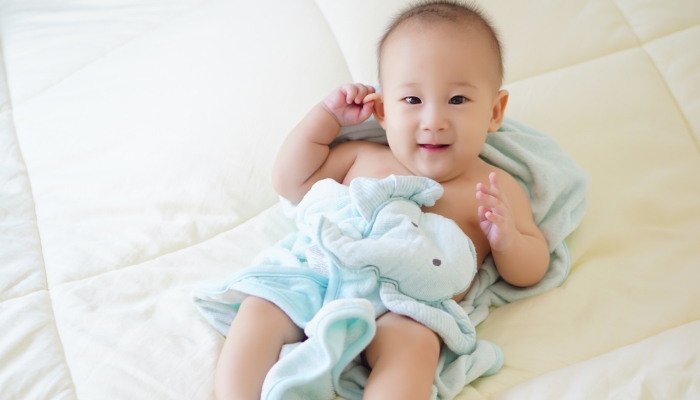
- Ear rubbing and ear pulling in a healthy infant can be an attempt to self-soothe.
- You can use many home remedies to relieve your baby’s ear pain.
- Call your doctor if your baby shows symptoms of illness combined with ear tugging or scratching.
Parents often worry about their ability to detect illness in their little one. Many symptoms of different conditions are the same, whether your child has a cold, ear infection, or something else.
Detecting illness is made particularly difficult because babies are unable to describe what they feel or point to where they are feeling pain. Researching topics such as “Why is my baby rubbing their ear?” may or may not yield information that will help at that moment. It can be hard to know what to do when your little one is in pain.
Fortunately, there are many ways you can help make your baby more comfortable, particularly when you suspect that their ears may be the problem.
Inside a Baby’s Ear
Did you know that a baby’s outer and inner ear differs from that of older children?
Young children (between three months and three years) are much more likely to develop ear problems or an ear infection related to these structural differences.
| Features of the Ear | Baby | Older Child/Adult |
| Eardrum | Flexible | More rigid |
| Ear Tubes (Eustachian Tubes) | More horizontal, narrower, flexible, shorter | Relatively vertical, wide, and rigid |
| Ear Canal | 14-15mm long | 23mm long |
| Ability to Drain Fluid | More likely to be blocked | No difficulty when healthy |
As your baby grows, the outer and middle ear will become more like an older child’s.
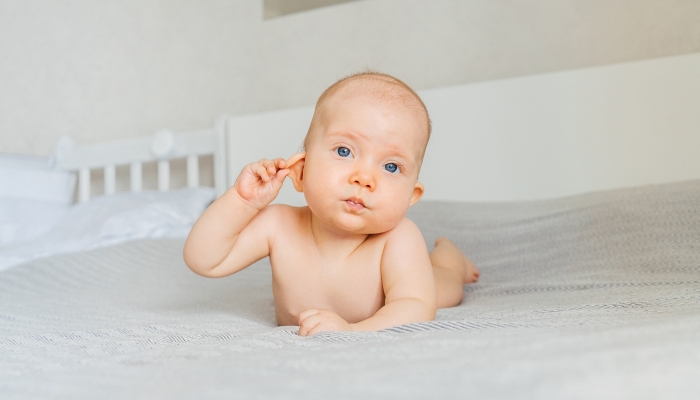
Do Babies Normally Rub and Pull Their Ears?
For most babies, scratching, pulling, or rubbing one or both ears are normal activities.
If you notice your child touching their ears more than usual, take a few moments to observe what else they’re doing. Your baby might be in the process of finding their ears attached to the rest of their body or signaling something else they feel.
Assuming your child is healthy and you don’t notice other symptoms, relax and continue to let your baby discover themselves.
Is Ear Rubbing in Babies a Sign of Teething?
When you find your little one rubbing or pulling their ear when they appear otherwise healthy, it could be a sign that new teeth are coming.
The nerves around your baby’s mouth stretch over to their ears. The formation of new teeth, whether or not they’re visible, can cause nerve irritation and pain.
Babies will often pull, rub, or tug on their ears in an attempt to self-soothe and relieve irritation and discomfort.
Reasons Why Babies Keep Rubbing Their Ears
Ear infections or teething aren’t always why babies engage in ear pulling or ear tugging. In most cases, your little one is self-soothing or alerting you to an ear problem they may be experiencing.
If you’re left scratching your head as to why your baby is playing with their ears, consider the following reasons:
- Fatigue: At times, rubbing their eyes or ears can be your baby’s cue that they’re ready for a nap.
- Trying to relieve congestion: If your little one has a cold or increased drooling because of teething, the increased mucus and saliva production can put pressure on the inner ear tubes or the eardrum, causing pain. Ear pulling can be your baby’s attempt to relieve their discomfort.
- Illness: Around this age, babies participate more in their environment and may begin to put new things in their mouths. These items may hold cold viruses and bacteria, which can make your baby sick without causing an ear infection,
- Self-soothing: Your baby is a clever little person and will attempt to comfort themselves when they can. Using a pacifier, sucking on a thumb or finger, or rubbing an ear can all signal that an upset child is working to soothe themselves.
- Body discovery: The main cause of ear pulling in healthy children ages four to twelve months is the exploration of these body parts. Your baby will poke and prod themselves as they learn how and where their ears are attached to their head.
A baby pulling on their ears is generally not a cause for concern unless there is also fever, increased crying, or other uncommon symptoms.
What to Do If Your Baby Keeps Rubbing Their Ear
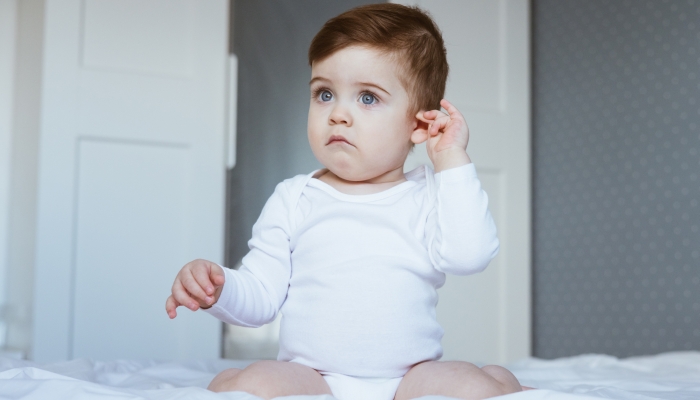
A constantly crying or fussy baby can be taxing for even the most seasoned parent. If you’ve noticed your little one is pulling or tugging at their ears, there are many ways you can try to help.
Allow Extra Feedings
Sucking and swallowing during feedings may increase pressure inside a sensitive ear canal, causing your little one to start ear pulling or crying during feedings. Feedings may be shorter than normal due to pain, or your little one may have difficulty eating.
If your baby appears dehydrated or you have other concerns, contact your pediatrician.
Holding
For most babies, their position of comfort when not feeling well is their parent’s arms.
In addition to the extra love and soothing an attentive parent can provide, being upright tends to help reduce ear canal and inner ear pressure. Normal soothing methods, such as a pacifier, can increase pain inside the ears when used.
Consider other methods to comfort your crying baby if your baby rejects their favorites when scratching, rubbing, or pulling their ears.
Ear Massage
Gentle massage of your baby’s ear may also help relieve pressure and fluid accumulation inside their ears.
Add Heat
Sometimes the most effective remedies are the simplest.
In my experience with my children, I’ve found that a warm (not hot) wet washcloth held against the painful ear can be soothing. I usually use this step as a temporary measure after waking from a nap or while I figure out what remedy to try next.
Rinse Well
Sometimes soap, shampoo, or other irritants enter your baby’s ear canal and dry there. This dried material can itch quite a bit, causing your child to pull or rub their ears.
Pain Medication
According to the American Academy of Pediatrics, a fever in a child younger than two months of age is considered a medical emergency.
Avoid giving any pain or fever-reducing medication for babies in the first twelve weeks of life unless approved by your pediatrician.
The same is true of natural or homeopathic remedies marketed to treat fever. Many of these remedies also contain honey, which is inappropriate for children under one due to the risk of botulism.
Ear Drops
Sometimes, your doctor may prescribe ear drops to help relieve pain and inflammation or treat an outer ear infection. These are gently inserted into your little one’s ear canal and (hopefully) remain there for several hours.
Ear drops are generally not used to treat an ear infection in the middle or inner ear. Oral antibiotics will be used to treat infection in these places.
Avoid Cotton Swabs
The use of cotton swabs is not recommended in children or very young babies.
Ear wax holds trapped foreign material before it reaches the ear canal or inner ear and is the ear’s way of cleaning itself.
Because a baby has a smaller, more flexible ear canal, cotton swabs usually push the wax further against the ear drum. A mass of ear wax deep in the ear canal will increase ear pressure and makes your little one more miserable.
You may notice that your child still seems distressed after you attempt to ease their discomfort. If so, a trip to the doctor may be needed to evaluate for other signs of an illness that requires treatment.
When to Bring Your Baby to the Doctor for Ear Rubbing and Pulling
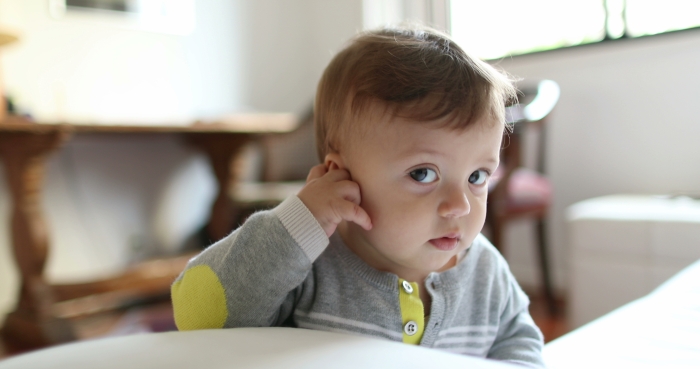
As with many other childhood illnesses, take a look at what else your child is doing to determine if a trip to the pediatrician is in order. At times, fluid in the middle ear is indeed present, but it may not be infected.
It may be time to seek care if your baby shows other signs of illness, such as:
- Fever
- Increased crying or irritability
- Flu symptoms (fatigue, body aches, chills)
- Ear pain (particularly when lying down)
- Drainage from the ear
- Outer ear redness, swelling, or warmth
- Vomiting
- Trouble sleeping
The infected fluid inside the ear will need treatment with an antibiotic to fully resolve symptoms.
Ear pulling can occur for a variety of reasons in healthy and sick babies. As your child grows, you will learn their unique symptoms of stress, fatigue, and illness and figure out healthy ways to help them through each stage.
What You Can Do To Prevent Ear Infections
According to the National Institute on Deafness and Other Communication Disorders, there are many steps you can take to help prevent ear infections in your child.
These include suggestions such as:
- Receive a flu vaccination every year.
- Use the 13-valent pneumococcal conjugate vaccine (PCV13) instead of the previously recommended vaccine (PCV7).
- Wash your hands frequently.
- Feed your baby (both breastfed or bottle-fed) in an upright position.
- Avoid exposing your baby to cigarette smoke, including secondhand smoke.
- Never put your baby down to sleep with a bottle.
- As much as is practically possible, avoid letting sick children spend time together.
References
- American Academy of Pediatrics. Ear Infections: What Parents Need to Know. AAP News. https://publications.aap.org/aapnews/news/10934. Published November 2008. Accessed April 25, 2023.
- American Academy of Pediatrics. Fever and Your Baby. HealthyChildren.org. https://www.healthychildren.org/English/health-issues/conditions/fever/Pages/Fever-and-Your-Baby.aspx. Accessed April 25, 2023.
- American Academy of Pediatrics. How to Give Ear Drops. HealthyChildren.org. https://www.healthychildren.org/English/safety-prevention/at-home/medication-safety/Pages/How-to-Give-Ear-Drops.aspx. Accessed April 25, 2023.
- Avital A, Donchin M, Springer C, Cohen S, Danino E. Feeding young infants with their head in upright position reduces respiratory and ear morbidity. Sci Rep. 2018 Apr 26;8(1):6588. doi: 10.1038/s41598-018-24636-0. PMID: 29700412; PMCID: PMC5920104.
- Lynne A. Werner, Early Development of the Human Auditory System, Editor(s): Richard A. Polin, William W. Fox, Steven H. Abman, Fetal and Neonatal Physiology (Fourth Edition), W.B. Saunders, 2011, Pages 1882-1899, ISBN 9781416034797, doi: 10.1016/B978-1-4160-3479-7.10171-5.
- Merck Manuals. Overview of Middle Ear Infections in Young Children. https://www.merckmanuals.com/home/children-s-health-issues/ear-nose-and-throat-disorders-in-children/overview-of-middle-ear-infections-in-young-children. Updated January 2022. Accessed April 25, 2023.
- Mount Sinai. Ear Wax. https://www.mountsinai.org/health-library/diseases-conditions/ear-wax. Accessed April 25, 2023.
- National Institute on Deafness and Other Communication Disorders. Ear Infections in Children. https://www.nidcd.nih.gov/health/ear-infections-children. Published September 2019. Accessed April 25, 2023.
- Seattle Children’s Hospital. Ear Pulling, At or Rubbing. https://www.seattlechildrens.org/conditions/a-z/ear-pulling-at-or-rubbing/. Accessed April 25, 2023.
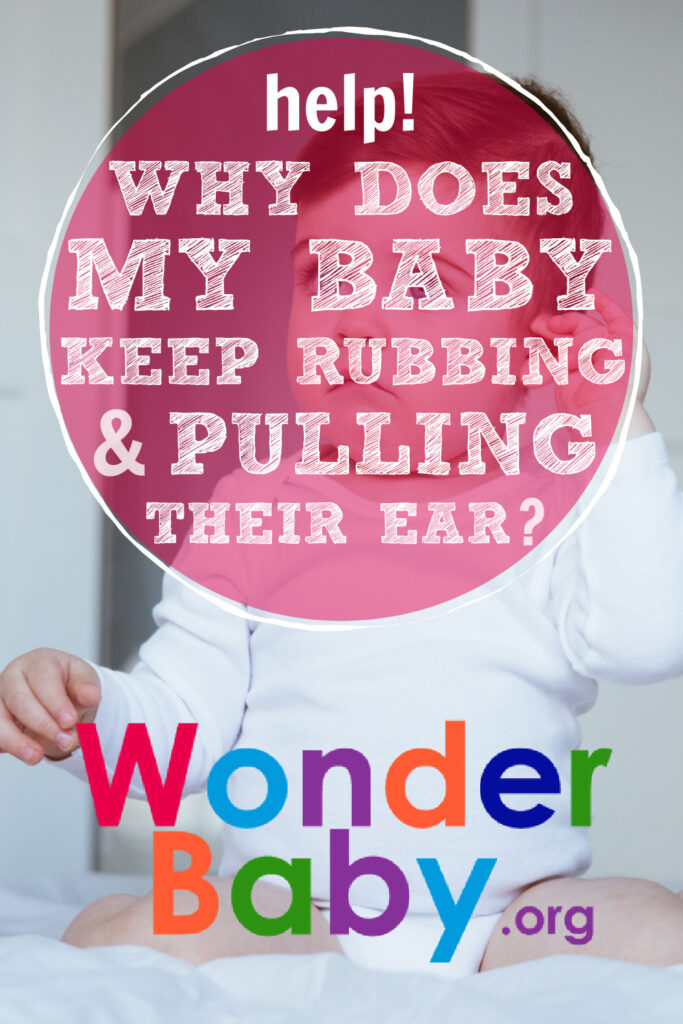
The information WonderBaby provides is not intended to be, and does not constitute, medical or other health advice or diagnosis and should not be used as such. Always consult with a qualified medical professional about your specific circumstances.
Related Posts

Eye Conditions and Syndromes, Visual Impairment
Neuralink Announces Plans to Restore Sight to the Blind with Brain Chip
Elon Musk’s company Neuralink has announced plans to begin human trials of its new “Blindsight” brain chip by the end of 2025.
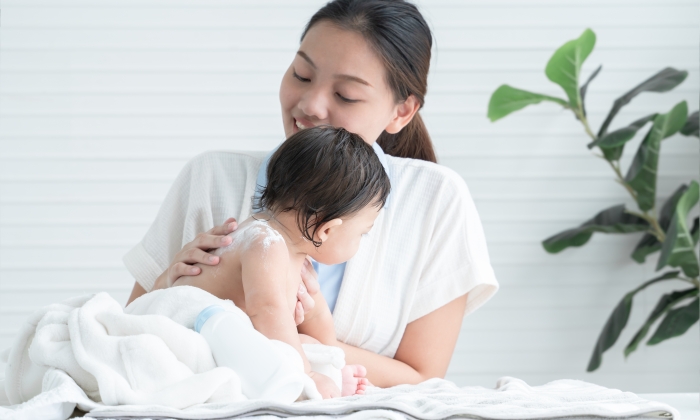
Health & Nutrition
Can Baby Skin Care Products Expire?
Is that forgotten tube of diaper rash cream still safe to use? Learn more about the expiration dates of popular skin care products for infants.

Health & Nutrition
Boosting Immunity in Kids: 3 Tips for a Healthy Winter
Parents can help boost their kids’ immunity during cold and flu season by maintaining healthy eating, sleeping, and exercising habits in the winter.